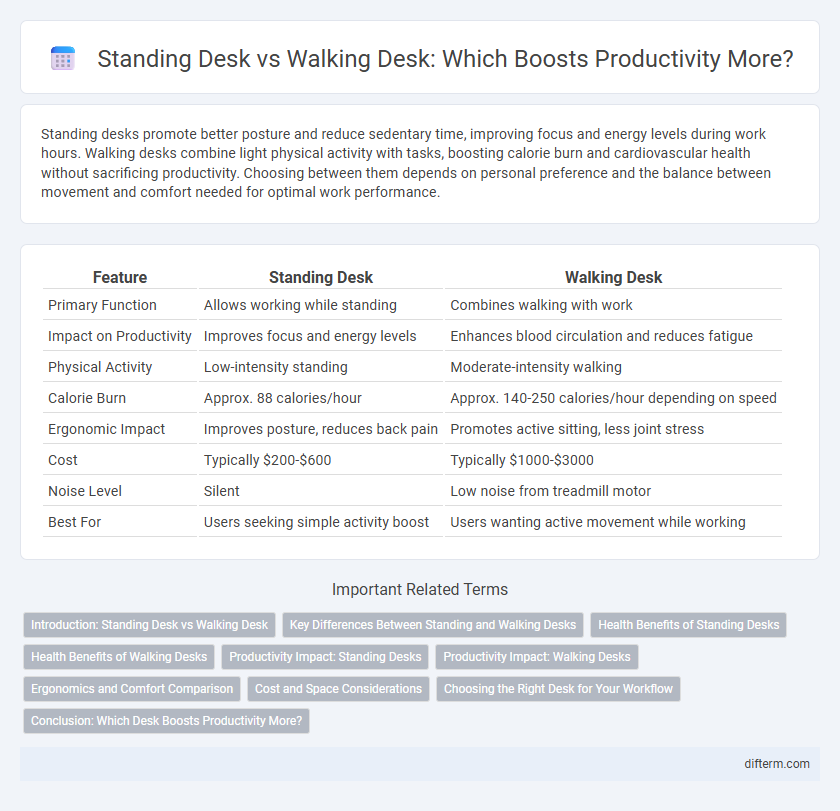Standing desks promote better posture and reduce sedentary time, improving focus and energy levels during work hours. Walking desks combine light physical activity with tasks, boosting calorie burn and cardiovascular health without sacrificing productivity. Choosing between them depends on personal preference and the balance between movement and comfort needed for optimal work performance.
Table of Comparison
| Feature | Standing Desk | Walking Desk |
|---|---|---|
| Primary Function | Allows working while standing | Combines walking with work |
| Impact on Productivity | Improves focus and energy levels | Enhances blood circulation and reduces fatigue |
| Physical Activity | Low-intensity standing | Moderate-intensity walking |
| Calorie Burn | Approx. 88 calories/hour | Approx. 140-250 calories/hour depending on speed |
| Ergonomic Impact | Improves posture, reduces back pain | Promotes active sitting, less joint stress |
| Cost | Typically $200-$600 | Typically $1000-$3000 |
| Noise Level | Silent | Low noise from treadmill motor |
| Best For | Users seeking simple activity boost | Users wanting active movement while working |
Introduction: Standing Desk vs Walking Desk
Standing desks offer a stable platform that encourages better posture, reduced sitting time, and increased focus during work hours. Walking desks incorporate slow movement at a controlled pace, promoting higher calorie burn and improved cardiovascular health without sacrificing productivity. Both options enhance workplace ergonomics, but their impact varies based on individual health goals and work habits.
Key Differences Between Standing and Walking Desks
Standing desks promote improved posture and reduce sedentary behavior by allowing users to stand while working, which can enhance focus and decrease back pain. Walking desks combine low-intensity physical activity with work, increasing calorie expenditure and cardiovascular benefits more than standing alone. The key difference lies in movement integration: standing desks encourage static standing, while walking desks facilitate continuous walking, impacting energy levels and physical health differently.
Health Benefits of Standing Desks
Standing desks promote improved posture and reduce the risks associated with prolonged sitting, such as cardiovascular disease and obesity. They enhance energy levels and focus by encouraging subtle movements and muscle engagement throughout the workday. Consistent use of standing desks can decrease the likelihood of developing musculoskeletal disorders and improve overall metabolic health.
Health Benefits of Walking Desks
Walking desks significantly enhance cardiovascular health by promoting continuous movement, which increases calorie burn and improves circulation compared to standing desks. They help reduce the risk of chronic diseases such as obesity, diabetes, and hypertension by maintaining an active posture during work hours. Incorporating walking desks into daily routines also alleviates muscle stiffness and enhances mental alertness, boosting overall productivity and well-being.
Productivity Impact: Standing Desks
Standing desks improve productivity by reducing discomfort and encouraging better posture, which enhances focus and energy levels throughout the workday. Studies indicate that employees using standing desks experience up to a 20% increase in task performance and a 50% reduction in reported fatigue. Integrating standing desks in office environments can lead to sustained productivity gains and improved overall employee well-being.
Productivity Impact: Walking Desks
Walking desks significantly enhance productivity by promoting continuous physical activity, which increases blood flow and oxygen to the brain, leading to improved focus and cognitive function. Employees using walking desks report higher energy levels and reduced fatigue, allowing sustained work performance throughout the day. Studies indicate that integrating walking desks into the workspace can boost task efficiency and creativity without compromising accuracy.
Ergonomics and Comfort Comparison
Standing desks promote better posture by allowing users to adjust desk height to their ergonomic needs, reducing strain on the neck and back. Walking desks combine light physical activity with work, enhancing circulation and reducing sedentary discomfort, though they may cause slight distraction during complex tasks. Ergonomically, standing desks provide stable support for prolonged use, while walking desks offer dynamic comfort suited for short periods, making choice dependent on user activity preference and task demands.
Cost and Space Considerations
Standing desks typically offer a more affordable price range and compact design compared to walking desks, which require additional mechanisms and space for treadmill movement. Walking desks can cost up to three times more and need a dedicated area of at least 7-9 feet in length to operate safely and comfortably. Budget-conscious buyers with limited office space often prefer standing desks for their easier integration and cost efficiency.
Choosing the Right Desk for Your Workflow
Selecting the right desk for your workflow depends on balancing comfort, movement, and task demands. Standing desks promote better posture and reduce sedentary time, ideal for focused tasks requiring minimal movement. Walking desks enhance circulation and energy levels by integrating light activity, making them suitable for routine or creative work that benefits from increased mobility.
Conclusion: Which Desk Boosts Productivity More?
Standing desks improve productivity by promoting better posture and reducing sedentary fatigue, while walking desks enhance cognitive function and energy levels through light physical activity. Studies show walking desks can increase focus and creativity but may cause slight coordination challenges during complex tasks. Choosing between the two depends on individual work style and task requirements, with walking desks offering superior dynamic engagement and standing desks providing consistent ergonomic support.
Standing desk vs walking desk Infographic

 difterm.com
difterm.com